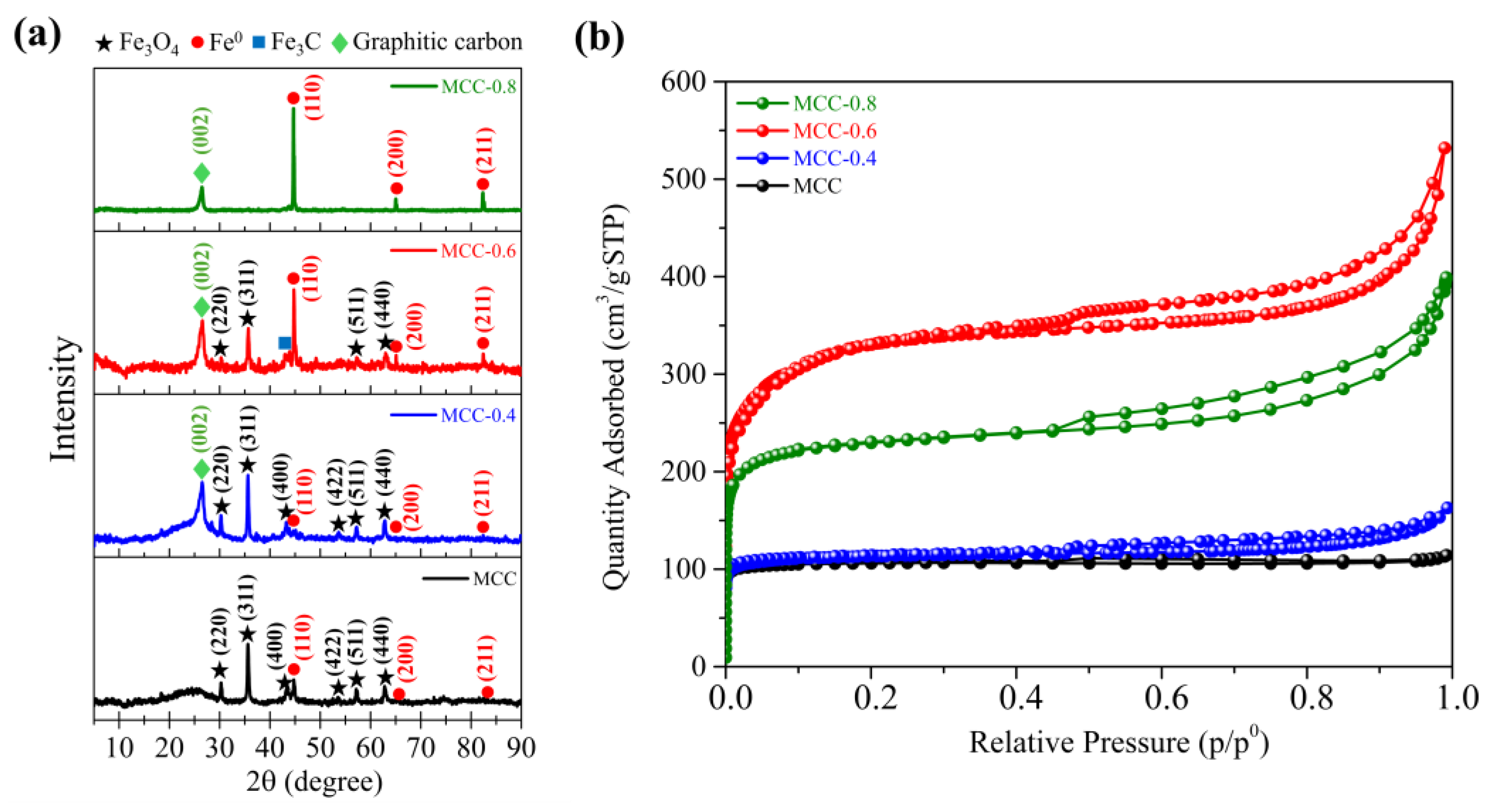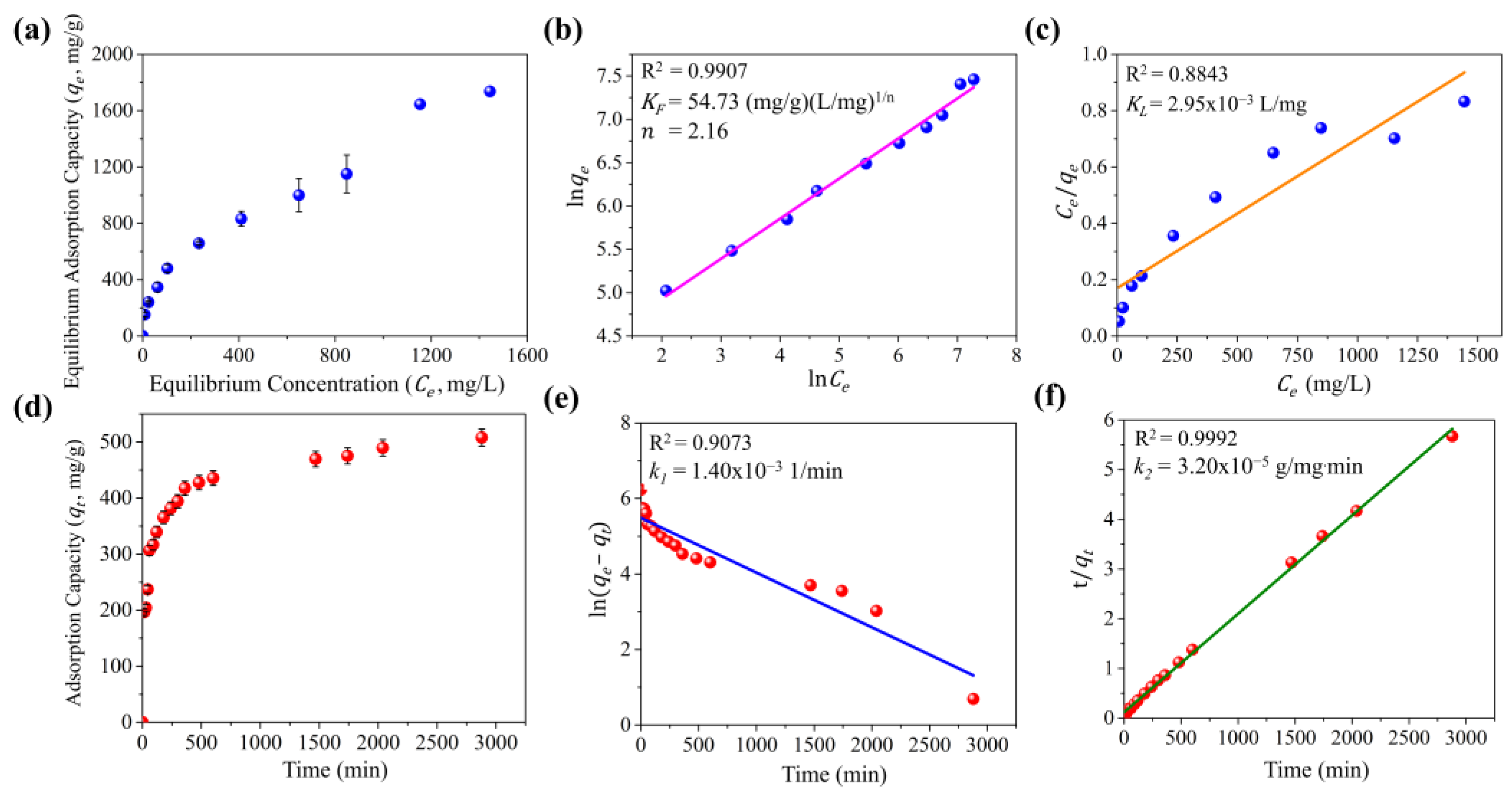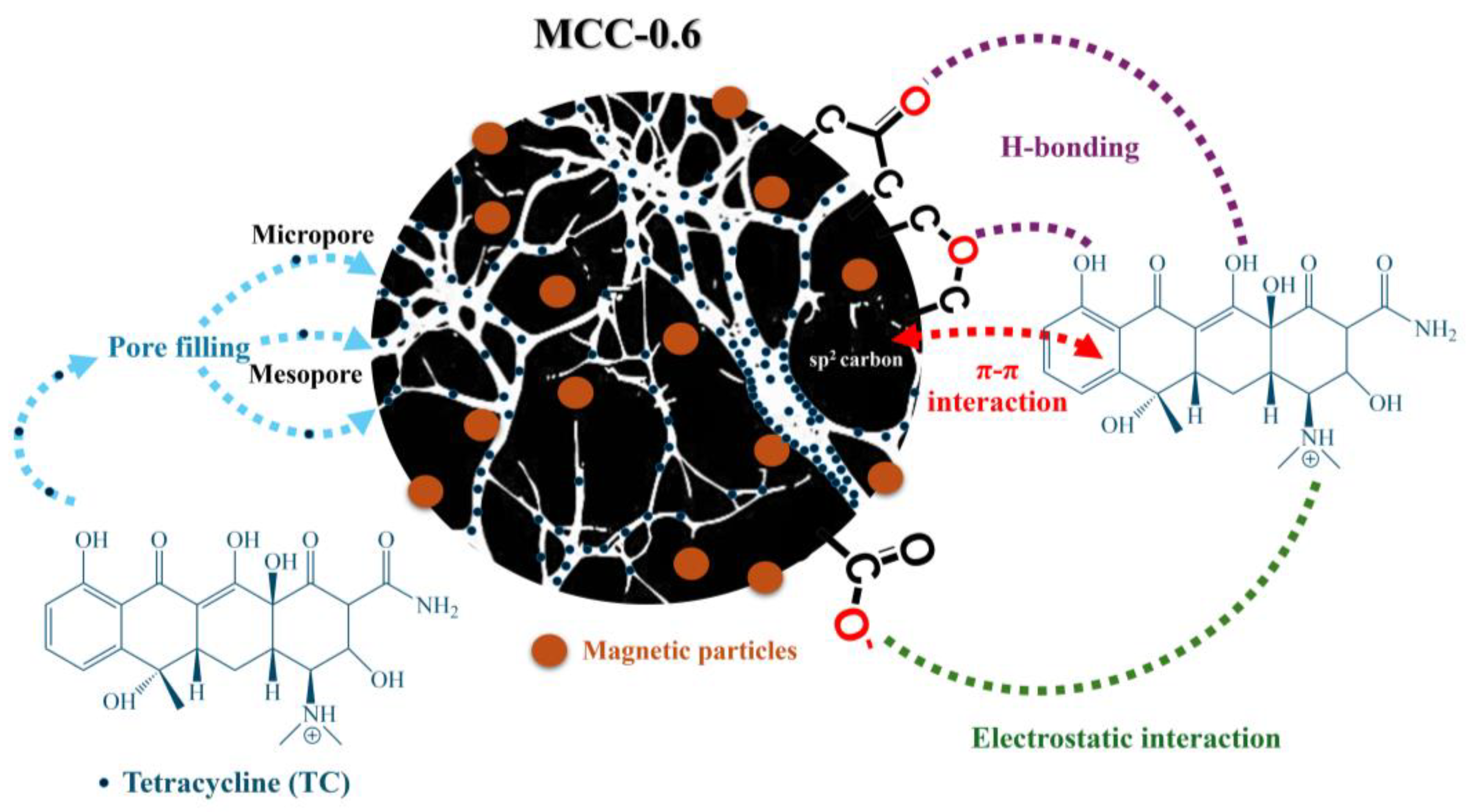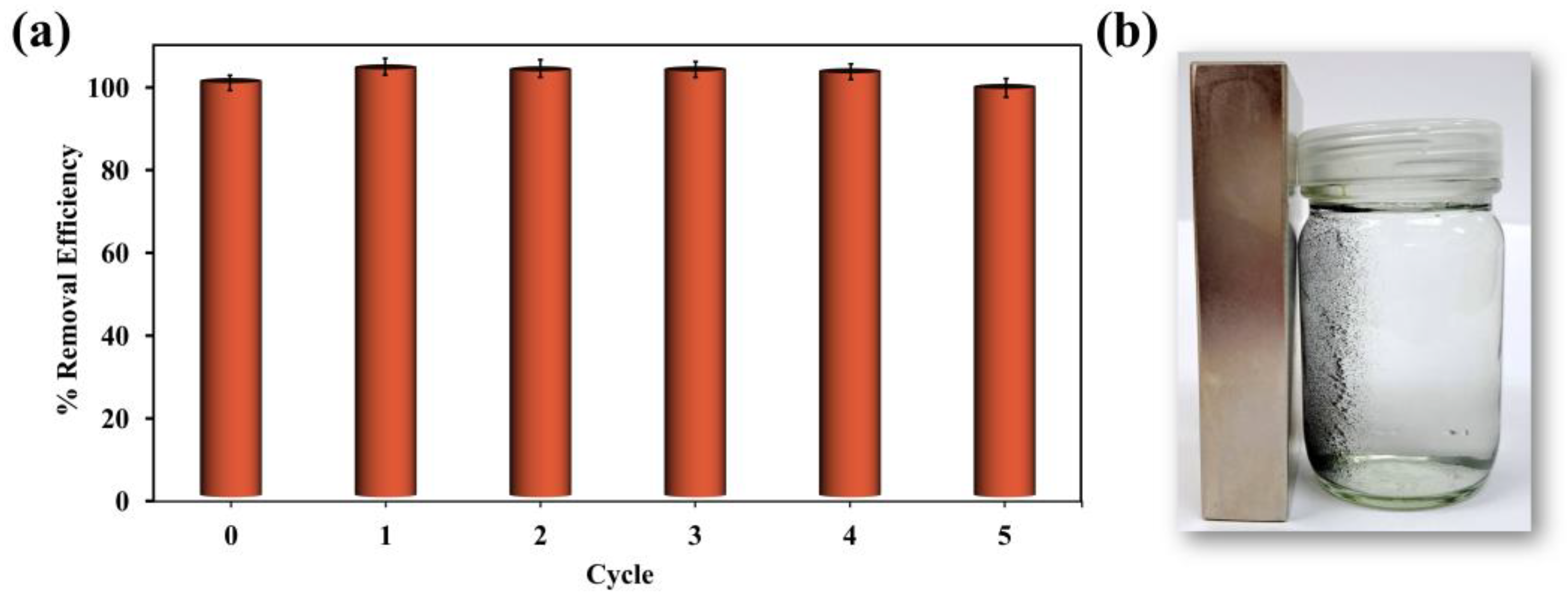Single-Step Upcycling of Sugarcane Bagasse and Iron Scrap into Magnetic Carbon for High-Performance Adsorbents
Abstract
1. Introduction
2. Results and Discussion
2.1. Material Characterization
2.2. Adsorption of Tetracycline
2.3. Comparative Study
2.4. Reusability of the Adsorbent
2.5. Adsorbent Application to a Real Water Resource
3. Materials and Methods
3.1. Materials
3.2. Preparation of Iron Scrap Solution
3.3. Preparation of Magnetic Carbon Materials
3.4. Material Characterization
3.5. Adsorption Studies
3.6. Regeneration Experiments
4. Conclusions
Supplementary Materials
Author Contributions
Funding
Institutional Review Board Statement
Informed Consent Statement
Data Availability Statement
Acknowledgments
Conflicts of Interest
References
- Mishra, R.K.; Mentha, S.S.; Misra, Y.; Dwivedi, N. Emerging pollutants of severe environmental concern in water and wastewater: A comprehensive review on current developments and future research. Water-Energy Nexus 2023, 6, 74–95. [Google Scholar] [CrossRef]
- Amangelsin, Y.; Semenova, Y.; Dadar, M.; Aljofan, M.; Bjørklund, G. The impact of tetracycline pollution on the aquatic environment and removal strategies. Antibiotics 2023, 12, 440. [Google Scholar] [CrossRef] [PubMed]
- Borghi, A.A.; Palma, M.A. Tetracycline: Production, waste treatment and environmental impact assessment. Braz. J. Pharm. Sci. 2014, 50, 25–40. [Google Scholar] [CrossRef]
- Zhang, Y.; Shi, J.; Xu, Z.; Chen, Y.; Song, D. Degradation of tetracycline in a schorl/H2O2 system: Proposed mechanism and intermediates. Chemosphere 2018, 202, 661–668. [Google Scholar] [CrossRef]
- Saitoh, T.; Shibata, K.; Fujimori, K.; Ohtani, Y. Rapid removal of tetracycline antibiotics from water by coagulation-flotation of sodium dodecyl sulfate and poly(allylamine hydrochloride) in the presence of Al(III) ions. Sep. Purif. Technol. 2017, 187, 76–83. [Google Scholar] [CrossRef]
- Li, X.; Fan, S.; Jin, C.; Gao, M.; Zhao, Y.; Guo, L.; Ji, J.; She, Z. Electrochemical degradation of tetracycline hydrochloride in sulfate solutions on boron-doped diamond electrode: The accumulation and transformation of persulfate. Chemosphere 2022, 305, 135448. [Google Scholar] [CrossRef] [PubMed]
- Li, X.; Zhou, J.; Jiang, S.; Lin, Z.; Jing, G.; He, Y.; Sun, Y.; Yang, Y.; Ma, S.; Zhang, X. Photocatalytic degradation of tetracycline hydrochloride and oxytetracycline using novel zinc-based coordination polymers constructed with mixed linkers. Polyhedron 2024, 261, 117133. [Google Scholar] [CrossRef]
- Wang, C.; Lin, C.-Y.; Liao, G.-Y. Feasibility study of tetracycline removal by ozonation equipped with an ultrafine-bubble compressor. Water 2021, 13, 1058. [Google Scholar] [CrossRef]
- Prado, N.; Ochoa, J.; Amrane, A. Biodegradation by activated sludge and toxicity of tetracycline into a semi-industrial membrane bioreactor. Bioresour. Technol. 2009, 100, 3769–3774. [Google Scholar] [CrossRef]
- Yu, F.; Li, Y.; Han, S.; Ma, J. Adsorptive removal of antibiotics from aqueous solution using carbon materials. Chemosphere 2016, 153, 365–385. [Google Scholar] [CrossRef]
- Gao, Y.; Li, Y.; Zhang, L.; Huang, H.; Hu, J.; Shah, S.M.; Su, X. Adsorption and removal of tetracycline antibiotics from aqueous solution by graphene oxide. J. Colloid Interface Sci. 2012, 368, 540. [Google Scholar] [CrossRef]
- Hang, J.; Guo, Z.; Zhong, C.; Sun, A.; He, K.; Liu, X.; Song, H.; Li, J. A super magnetic porous biochar manufactured by potassium ferrate-accelerated hydrothermal carbonization for removal of tetracycline. J. Clean. Prod. 2024, 435, 140470. [Google Scholar] [CrossRef]
- Liang, H.; Zhu, C.; Wang, A.; Chen, F. Facile preparation of NiFe2O4/biochar composite adsorbent for efficient adsorption removal of antibiotics in water. Carbon Res. 2024, 3, 2. [Google Scholar] [CrossRef]
- Chen, A.; Wang, N.; Tian, Z.; Wei, X.; Lei, C. One-step synthesis of readily recyclable poplar sawdust-based porous carbon for the adsorption of tetracycline. Ind. Crops Prod. 2023, 197, 116621. [Google Scholar] [CrossRef]
- Zhao, L.; He, P.; Li, Q.; Pan, H.; Xie, T.; Huang, S.; Cao, S.; Liu, X. Efficiently removal of tetracycline from water by Fe3O4-sludge biochar. Water, Air, Soil Pollut. 2023, 235, 38. [Google Scholar] [CrossRef]
- Dutta, J.; Mala, A.A. Removal of antibiotic from the water environment by the adsorption technologies: A review. Water Sci Technol. 2020, 82, 401–426. [Google Scholar] [CrossRef]
- Priya, S.S.; Radha, K.V. A review on the adsorption studies of tetracycline onto various types of adsorbents. Chem. Eng. Commun. 2017, 204, 821–839. [Google Scholar] [CrossRef]
- Mansour, F.; Al-Hindi, M.; Yahfoufi, R.; Ayoub, G.; Ahmad, M. The use of activated carbon for the removal of pharmaceuticals from aqueous solutions: A review. Rev. Environ. Sci. Biotechnol 2018, 17, 109–145. [Google Scholar] [CrossRef]
- Qin, Y.; Chai, B.; Wang, C.; Yan, J.; Fan, G.; Song, G. New insight into remarkable tetracycline removal by enhanced graphitization of hierarchical porous carbon aerogel: Performance and mechanism. Colloids Surf. A Physicochem. Eng. Asp. 2022, 655, 130197. [Google Scholar] [CrossRef]
- Zhang, L.; Song, X.; Liu, X.; Yang, L.; Pan, F.; Lv, J. Studies on the removal of tetracycline by multi-walled carbon nanotubes. Chem. Eng. J. 2011, 178, 26–33. [Google Scholar] [CrossRef]
- Minale, M.; Gu, Z.; Guadie, A.; Kabtamu, D.M.; Li, Y.; Wang, X. Application of graphene-based materials for removal of tetracyclines using adsorption and photocatalytic-degradation: A review. J. Environ. Manag. 2020, 276, 111310. [Google Scholar] [CrossRef]
- Sanni, S.O.; Oluokun, O.; Akpotu, S.O.; Pholosi, A.; Pakade, V.E. Removal of tetracycline from the aquatic environment using activated carbon: A comparative study of adsorption performance based on the activator agents. Heliyon 2024, 10, e34637. [Google Scholar] [CrossRef] [PubMed]
- Vinayagam, R.; Quadras, M.; Varadavenkatesan, T.; Debraj, D.; Goveas, L.C.; Samanth, A.; Balakrishnan, D.; Selvaraj, R. Magnetic activated carbon synthesized using rubber fig tree leaves for adsorptive removal of tetracycline from aqueous solutions. Environ. Res. 2023, 216, 114775. [Google Scholar] [CrossRef]
- Jia, Z.; Wu, L.; Zhang, D.; Han, C.; Li, M.; Wei, R. Adsorption behaviors of magnetic carbon derived from wood tar waste for removal of methylene blue dye. Diam. Relat. Mater. 2022, 130, 109408. [Google Scholar] [CrossRef]
- Zhu, X.; Liu, Y.; Zhou, C.; Zhang, S.; Chen, J. Novel and high-performance magnetic carbon composite prepared from waste hydrochar for dye removal. ACS Sustain. Chem. Eng. 2014, 2, 969–977. [Google Scholar] [CrossRef]
- Liu, Y.; Zhu, X.; Qian, F.; Zhang, S.; Chen, J. Magnetic activated carbon prepared from rice straw-derived hydrochar for triclosan removal. RSC Adv. 2014, 4, 63620–63626. [Google Scholar] [CrossRef]
- Deng, Y.; Chen, J.; She, A.; Ni, F.; Chen, W.; Ao, T.; Zhang, Y. A novel Fe-loaded porous hydrothermal biochar for removing tetracycline from wastewater: Performance, mechanism, and fixed-bed column. J. Environ. Chem. Eng. 2024, 12, 112256. [Google Scholar] [CrossRef]
- Huang, J.; Wang, J.; Lei, S.; Zhang, Y.; Zhang, M.; Hu, Z.; Sharaf, F. Iron-loaded porous semi-coke activated carbon as a highly effective and recyclable adsorbent for tetracycline removal in wastewater. Water Air Soil Pollut. 2024, 235, 287. [Google Scholar] [CrossRef]
- Liu, Y.; Huo, Z.; Song, Z.; Zhang, C.; Ren, D.; Zhong, H.; Jin, F. Preparing a magnetic activated carbon with expired beverage as carbon source and KOH as activator. J. Taiwan Inst. Chem. Eng. 2019, 96, 575–587. [Google Scholar] [CrossRef]
- Zhang, Z.; Wang, T.; Zhang, H.; Liu, Y.; Xing, B. Adsorption of Pb(II) and Cd(II) by magnetic activated carbon and its mechanism. Sci. Total Environ. 2021, 757, 143910. [Google Scholar] [CrossRef]
- Yang, X.; Wang, B.; Cheng, F. Adsorption performance on tetracycline by novel magnetic adsorbent derived from hydrochar of low-rank coal and sewage sludge. Sep. Purif. Technol. 2024, 330, 125482. [Google Scholar] [CrossRef]
- Fuat, G.; Cumali, Y. Synthesis, characterization, and lead (II) sorption performance of a new magnetic separable composite: MnFe2O4@wild plants-derived biochar. J. Environ. Chem. Eng. 2021, 9, 104567. [Google Scholar] [CrossRef]
- Zou, C.; Wu, Q.; Nie, F.; Xu, Z.; Xiang, S. Application of magnetic porous graphite biochar prepared through one-step modification in the adsorption of tetracycline and ciprofloxacin from aqueous solutions. Waste Biomass Valorization 2024, 15, 1477–1494. [Google Scholar] [CrossRef]
- Sun, M.; Ma, Y.; Yang, Y.; Zhu, X. Effect of iron impregnation ratio on the properties and adsorption of KOH activated biochar for removal of tetracycline and heavy metals. Bioresour. Technol. 2023, 380, 129081. [Google Scholar] [CrossRef]
- Xiang, Y.; Zhou, Y.; Yao, B.; Sun, Y.; Khan, E.; Li, W.; Zeng, G.; Yang, J.; Zhou, Y. Vinasse-based biochar magnetic composites: Adsorptive removal of tetracycline in aqueous solutions. Environ. Sci. Pollut. Res. 2023, 30, 8916–8927. [Google Scholar] [CrossRef]
- Cazetta, A.L.; Pezoti, O.; Bedin, K.C.; Silva, T.L.; Paesano Junior, A.; Asefa, T.; Almeida, V.C. Magnetic activated carbon derived from biomass waste by concurrent synthesis: Efficient adsorbent for toxic dyes. ACS Sustain. Chem. Eng. 2016, 4, 1058–1068. [Google Scholar] [CrossRef]
- Zeng, S.; Kan, E. FeCl3-activated biochar catalyst for heterogeneous Fenton oxidation of antibiotic sulfamethoxazole in water. Chemosphere 2022, 306, 135554. [Google Scholar] [CrossRef]
- Zhang, M.; Gao, B.; Varnoosfaderani, S.; Hebard, A.; Yao, Y.; Inyang, M. Preparation and characterization of a novel magnetic biochar for arsenic removal. Bioresour. Technol. 2013, 130, 457–462. [Google Scholar] [CrossRef]
- Pinakana, S.D.; Raysoni, A.U.; Sayeed, A.; Gonzalez, J.L.; Temby, O.; Wladyka, D.; Sepielak, K.; Gupta, P. Review of agricultural biomass burning and its impact on air quality in the continental United States of America. Environ. Adv. 2024, 16, 100546. [Google Scholar] [CrossRef]
- Laopaiboon, P.; Thani, A.; Leelavatcharamas, V.; Laopaiboon, L. Acid hydrolysis of sugarcane bagasse for lactic acid production. Bioresour. Technol. 2010, 101, 1036–1043. [Google Scholar] [CrossRef]
- Rattanachueskul, N.; Saning, A.; Kaowphong, S.; Chumha, N.; Chuenchom, L. Magnetic carbon composites with a hierarchical structure for adsorption of tetracycline, prepared from sugarcane bagasse via hydrothermal carbonization coupled with simple heat treatment process. Bioresour. Technol. 2017, 226, 164–172. [Google Scholar] [CrossRef]
- Canilha, L.; Chandel, A.K.; dos Santos Milessi, T.; Antunes, F.A.F.; da Costa Freitas, W.; das Graças Almeida Felipe, M.; da Silva, S.S. Bioconversion of sugarcane biomass into ethanol: An overview about composition, pretreatment methods, detoxification of hydrolysates, enzymatic saccharification, and ethanol fermentation. BioMed Res. Int. 2012, 2012, 989572. [Google Scholar] [CrossRef] [PubMed]
- Kim, S.; Lee, S.-E.; Baek, S.-H.; Choi, U.; Bae, H.-J. Preparation of activated carbon from korean anthracite: Simultaneous control of ash reduction and pore development. Processes 2023, 11, 2887. [Google Scholar] [CrossRef]
- Wang, Y.; Chen, W.; Zhao, B.; Wang, H.; Qin, L.; Han, J. Preparation of high-performance toluene adsorbents by sugarcane bagasse carbonization combined with surface modification. RSC Adv. 2020, 10, 23749–23758. [Google Scholar] [CrossRef]
- Hiranobe, C.T.; Gomes, A.S.; Paiva, F.F.G.; Tolosa, G.R.; Paim, L.L.; Dognani, G.; Cardim, G.P.; Cardim, H.P.; dos Santos, R.J.; Cabrera, F.C. Sugarcane bagasse: Challenges and opportunities for waste recycling. Clean Technol. 2024, 6, 662–699. [Google Scholar] [CrossRef]
- Wu, J.; Hou, B.; Wang, X.; Liu, Z.; Wang, Z.; Liu, B.; Li, S.; Gao, H.; Zhu, X.; Mao, Y. Preparation of N,S-codoped magnetic bagasse biochar and adsorption characteristics for tetracycline. RSC Adv. 2022, 12, 11786–11795. [Google Scholar] [CrossRef]
- Fu, Y.; Shen, Y.; Zhang, Z.; Ge, X.; Chen, M. Activated bio-chars derived from rice husk via one- and two-step KOH-catalyzed pyrolysis for phenol adsorption. Sci. Total Environ. 2019, 646, 1567–1577. [Google Scholar] [CrossRef]
- Biswas, A.; Patra, A.K.; Sarkar, S.; Das, D.; Chattopadhyay, D.; De, S. Synthesis of highly magnetic iron oxide nanomaterials from waste iron by one-step approach. Colloids Surf. A Physicochem. Eng. Asp. 2020, 589, 124420. [Google Scholar] [CrossRef]
- Thaveemas, P.; Chuenchom, L.; Kaowphong, S.; Techasakul, S.; Saparpakorn, P.; Dechtrirat, D. Magnetic carbon nanofiber composite adsorbent through green in-situ conversion of bacterial cellulose for highly efficient removal of bisphenol A. Bioresour. Technol. 2021, 333, 125184. [Google Scholar] [CrossRef]
- Xu, Z.; Zhou, Y.; Sun, Z.; Zhang, D.; Huang, Y.; Gu, S.; Chen, W. Understanding reactions and pore-forming mechanisms between waste cotton woven and FeCl3 during the synthesis of magnetic activated carbon. Chemosphere 2020, 241, 125120. [Google Scholar] [CrossRef]
- Thiruppathi, K.P.; Nataraj, D. Phase transformation from α-Fe2O3 to Fe3O4 and LiFeO2 by the self-reduction of Fe(III) in Prussian red in the presence of alkali hydroxides: Investigation of the phase dependent morphological and magnetic properties. CrystEngComm 2017, 19, 6170–6181. [Google Scholar] [CrossRef]
- Thompson, E.; Danks, A.E.; Bourgeois, L.; Schnepp, Z. Iron-catalyzed graphitization of biomass. Green Chem. 2015, 17, 551–556. [Google Scholar] [CrossRef]
- Hunter, R.D.; Ramírez-Rico, J.; Schnepp, Z. Iron-catalyzed graphitization for the synthesis of nanostructured graphitic carbons. J. Mater. Chem. A 2022, 10, 4489–4516. [Google Scholar] [CrossRef]
- Gomez-Martin, A.; Schnepp, Z.; Ramirez-Rico, J. Structural evolution in iron-catalyzed graphitization of hard carbons. Chem. Mater. 2021, 33, 3087–3097. [Google Scholar] [CrossRef]
- Glatzel, S.; Schnepp, Z.; Giordano, C. From paper to structured carbon electrodes by inkjet printing. Angew. Chem. Int. Ed. Engl. 2013, 52, 2355–2358. [Google Scholar] [CrossRef]
- Chun, S.E.; Whitacre, J.F. Formation of micro/mesopores during chemical activation in tailor-made nongraphitic carbons. Microporous Mesoporous Mater. 2017, 251, 34–41. [Google Scholar] [CrossRef]
- Nogueira, G.A.; Fregolente, L.G.; Pereira, L.S.; Laranja, M.J.; Moreira, A.B.; Ferreira, O.P.; Bisinoti, M.C. Magnetic activated carbonaceous materials from sugarcane bagasse: Preparation, characterization, and hexavalent chromium removal. Mater. Today Sustain. 2024, 28, 101040. [Google Scholar] [CrossRef]
- Liu, P.; Sun, S.; Huang, S.; Wu, Y.; Li, X.; Wei, X.; Wu, S. KOH activation mechanism in the preparation of Brewer’s spent grain-based activated carbons. Catalysts 2024, 14, 814. [Google Scholar] [CrossRef]
- Zhang, J.; Zhang, X.; Li, X.; Song, Z.; Shao, J.; Zhang, S.; Yang, H.; Chen, H. Prediction of CO2 adsorption of biochar under KOH activation via machine learning. Carbon Capture Sci. Technol. 2024, 13, 100309. [Google Scholar] [CrossRef]
- Song, X.; Zhang, Y.; Chang, C. Novel method for preparing activated carbons with high specific surface area from rice husk. Ind. Eng. Chem. Res. 2012, 51, 15075–15081. [Google Scholar] [CrossRef]
- Nandi, R.; Jha, M.K.; Guchhait, S.K.; Sutradhar, D.; Yadav, S. Impact of KOH activation on rice husk derived porous activated carbon for carbon capture at flue gas alike temperatures with high CO2/N2 selectivity. ACS Omega 2023, 8, 4802–4812. [Google Scholar] [CrossRef]
- Schott, J.A.; Do-Thanh, C.L.; Shan, W.; Puskar, N.G.; Dai, S.; Mahurin, S.M. FTIR investigation of the interfacial properties and mechanisms of CO2 sorption in porous ionic liquids. Green Chem. Eng. 2021, 2, 392–401. [Google Scholar] [CrossRef]
- Jabarullah, N.H.; Kamal, A.S.; Othman, R. A modification of palm waste lignocellulosic materials into biographite using iron and nickel catalyst. Processes. 2021, 9, 1079. [Google Scholar] [CrossRef]
- Ivanov, Y.; Alfadhel, A.; Alnassar, M.; Perez, J.; Vazquez, M.; Chuvilin, A.; Kosel, J. Tunable magnetic nanowires for biomedical and harsh environment applications. Sci. Rep. 2016, 6, 24189. [Google Scholar] [CrossRef] [PubMed]
- Dutta, S.; Sharma, S.; Sharma, A.; Sharma, R. Fabrication of core–shell-structured organic–inorganic hybrid nanocatalyst for the expedient synthesis of polysubstituted oxazoles via tandem oxidative cyclization pathway. ACS Omega 2017, 2, 2778–2791. [Google Scholar] [CrossRef]
- Sevilla, M.; Salinas Martínez-de Lecea, C.; Valdés-Solís, T.; Morallón, E.; Fuertes, A.B. Solid-phase synthesis of graphitic carbon nanostructures from iron and cobalt gluconates and their utilization as electrocatalyst supports. Phys. Chem. Chem. Phys. 2008, 10, 1433–1442. [Google Scholar] [CrossRef] [PubMed]
- Reynel-Ávila, H.E.; Camacho-Aguilar, K.I.; Bonilla-Petriciolet, A.; Mendoza-Castillo, D.I.; González-Ponce, H.A.; Trejo-Valencia, R. Engineered magnetic carbon-based adsorbents for the removal of water priority pollutants: An overview. Adsorpt. Sci. Technol. 2021, 2021, 9917444. [Google Scholar] [CrossRef]
- Han, R.; Song, Y.; Duan, J.; Ai, S. A recyclable biochar with ultrahigh absorption ability for efficient removal of tetracycline hydrochloride. Colloids Surf. A Physicochem. Eng. Asp. 2024, 702, 134974. [Google Scholar] [CrossRef]
- López, G.P.; Castner, D.G.; Ratner, B.D. XPS O 1s binding energies for polymers containing hydroxyl, ether, ketone and ester groups. Surf. Interface Anal. 1991, 17, 267–272. [Google Scholar] [CrossRef]
- Qiu, C.; Jiang, L.; Gao, Y.; Sheng, L. Effects of oxygen-containing functional groups on carbon materials in supercapacitors: A review. Mater. Des. 2023, 230, 111952. [Google Scholar] [CrossRef]
- Sulaiman, N.S.; Mohamad-Amini, M.H.; Danish, M.; Sulaiman, O.; Hashim, R. Kinetics, thermodynamics, and isotherms of methylene blue adsorption study onto Cassava stem activated carbon. Water 2021, 13, 2936. [Google Scholar] [CrossRef]
- Huang, B.; Huang, D.; Zheng, Q.; Yan, C.; Feng, J.; Gao, H.; Fu, H.; Liao, Y. Enhanced adsorption capacity of tetracycline on porous graphitic biochar with an ultra-large surface area. RSC Adv. 2023, 13, 10397–10407. [Google Scholar] [CrossRef] [PubMed]
- Tran, D.-T.; Thi-My-Trinh, H.; Thi-An-Hang, N.; Viet-Cuong, D.; Dao, V.-D. Facile preparation of reduced graphene oxide for removing tetracycline from water: Kinetics and thermodynamics studies. Sep. Sci. Technol. 2022, 57, 1872–1883. [Google Scholar] [CrossRef]
- Wang, Y.; Xu, L.; Wei, F.; Ding, T.; Zhang, M.; Zhu, R. Insights into the adsorption mechanism of tetracycline on hierarchically porous carbon and the effect of nanoporous geometry. Chem. Eng. J. 2022, 437, 135454. [Google Scholar] [CrossRef]
- Bao, J.; Zhu, Y.; Yuan, S.; Wang, F.; Tang, H.; Bao, Z.; Zhou, H.; Chen, Y. Adsorption of tetracycline with reduced graphene oxide decorated with MnFe2O4 nanoparticles. Nanoscale Res. Lett. 2018, 13, 396. [Google Scholar] [CrossRef]
- Rangabhashiyam, S.; Balasubramanian, P. The potential of lignocellulosic biomass precursors for biochar production: Performance, mechanism and wastewater application—A review. Ind. Crops Prod. 2019, 128, 405–423. [Google Scholar] [CrossRef]
- Elyounssi, K.; Collard, F.-X.; Mateke, J.N.; Blin, J. Improvement of charcoal yield by two-step pyrolysis on Eucalyptus wood: A thermogravimetric study. Fuel 2012, 96, 161–167. [Google Scholar] [CrossRef]
- Lee, S.-H.; Kim, J.-H.; Kim, W.-S.; Roh, J.-S. The effect of the heating rate during carbonization on the porosity, strength, and electrical resistivity of graphite blocks using phenolic resin as a binder. Materials 2022, 15, 3259. [Google Scholar] [CrossRef]





| Material | SBET (m2/g) | Total Pore Volume (cm3/g) a | Micropore Volume (cm3/g) b | Mesopore Volume (cm3/g) c | Adsorption Capacity of TC (mg/g) d |
|---|---|---|---|---|---|
| MCC | 435 | 0.14 | 0.13 | 0.01 | 209.58 ± 0.64 |
| MCC-0.4 | 451 | 0.22 | 0.15 | 0.07 | 254.14 ± 0.34 |
| MCC-0.6 | 1238 | 0.70 | 0.39 | 0.31 | 872.19 ± 0.28 |
| MCC-0.8 | 874 | 0.46 | 0.27 | 0.18 | 705.84 ± 1.26 |
Disclaimer/Publisher’s Note: The statements, opinions and data contained in all publications are solely those of the individual author(s) and contributor(s) and not of MDPI and/or the editor(s). MDPI and/or the editor(s) disclaim responsibility for any injury to people or property resulting from any ideas, methods, instructions or products referred to in the content. |
© 2025 by the authors. Licensee MDPI, Basel, Switzerland. This article is an open access article distributed under the terms and conditions of the Creative Commons Attribution (CC BY) license (https://creativecommons.org/licenses/by/4.0/).
Share and Cite
Mahawong, S.; Thaveemas, P.; Onsri, P.; Kaowphong, S.; Watcharin, W.; Techasakul, S.; Dechtrirat, D.; Chuenchom, L. Single-Step Upcycling of Sugarcane Bagasse and Iron Scrap into Magnetic Carbon for High-Performance Adsorbents. Molecules 2025, 30, 2040. https://doi.org/10.3390/molecules30092040
Mahawong S, Thaveemas P, Onsri P, Kaowphong S, Watcharin W, Techasakul S, Dechtrirat D, Chuenchom L. Single-Step Upcycling of Sugarcane Bagasse and Iron Scrap into Magnetic Carbon for High-Performance Adsorbents. Molecules. 2025; 30(9):2040. https://doi.org/10.3390/molecules30092040
Chicago/Turabian StyleMahawong, Sirinad, Piyatida Thaveemas, Parichart Onsri, Sulawan Kaowphong, Waralee Watcharin, Supanna Techasakul, Decha Dechtrirat, and Laemthong Chuenchom. 2025. "Single-Step Upcycling of Sugarcane Bagasse and Iron Scrap into Magnetic Carbon for High-Performance Adsorbents" Molecules 30, no. 9: 2040. https://doi.org/10.3390/molecules30092040
APA StyleMahawong, S., Thaveemas, P., Onsri, P., Kaowphong, S., Watcharin, W., Techasakul, S., Dechtrirat, D., & Chuenchom, L. (2025). Single-Step Upcycling of Sugarcane Bagasse and Iron Scrap into Magnetic Carbon for High-Performance Adsorbents. Molecules, 30(9), 2040. https://doi.org/10.3390/molecules30092040









